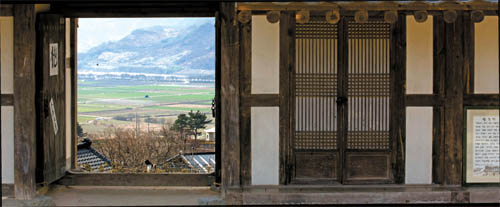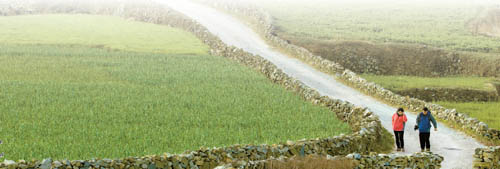Korea joins movement to slow down

A view of the wild tea fields at Agyang in Hadong County, South Gyeongsang. By Cho Young-chul
But more than a few would argue that a fast-paced life is inhumane because such a lifestyle leaves little time to sit down with your family and enjoy a decent meal or head to the hills and get a lungful of fresh air.
And even if people are interested in living slowly, they don’t know how to because they’ve always been busy.
Slow down, you move too fast

Straight lines are hard to find on Cheongsan Island, South Jeolla. By Cho Young-chul
In Korea, five cities have been designated so far. In fact, Korea is the only Asian country which has so-called slow cities.
In Italian, citta slow means a slow life.
Currently, 16 countries and 111 cities are designated as slow cities.
Island serenity
Sinan County, South Jeolla, became Korea’s first slow city in December 2007. The latest is Hadong County, South Gyeongsang, which was granted this status in January.
Perhaps the archetypal slow city is Cheongsan Island, one of the 201 islands off the coast of Wando County, South Jeolla.
It was the setting for the award-winning Korean film “Seopyonje” (1993), which was about a family struggling to make ends meet by singing pansori, a mix of Korean traditional vocals and percussion.
Officials from Cittaslow said the island came close to the very spirit of slow life when they went there to evaluate its environment in 2007.
The island is about one hour by boat from Wando. It’s covered with green barley at this time of year.
Cheong means blue and san means mountain, but the Chinese character cheong also means green.
Cheongsan Island is also known for its curves because there are so few straight roads, which means that locals spend more time walking in the countryside.
Only four taxis are available on the island and the drivers are also de facto tour guides.
But the most common transportation on the island is the tractor; the island reverberates with the sound of the tractors’ engines as they carry people to and fro throughout the day.
“This is nothing but a poor fishing village. A total of 2,613 people reside on this island. Most of them are senior citizens,” said Park Eun-kyung, the head of the local council.
Wando will host the first World Slow Walking Festival on April 18 and 19.
On the second day of the festival, participants will walk about 8 kilometers (5 miles) along the curvy island roads.
A sip in time
Another Cittaslow city is Hadong, one of Korea’s best known tea-producing regions.
The area is famous for not using chemical fertilizers in its tea production process. In addition, nobody trims the tea plantations, so the fields there don’t look like the neat ones you see in other areas.
Hadong looks much wilder, more like a tropical forest.
These factors impressed the officials from the Cittaslow movement.
One of the highlights of Hadong is Agyang Village where you can see traditional farming techniques still practiced.
This landscape was the setting for the classic novel, “Toji (The Land),” by the late author Park Kyung-ree.
The story chronicles turbulent phases in modern Korean history. Park took 25 years to complete all 16 volumes and five serials of Toji.
Salt, mushrooms and sauces
Sinan County, South Jeolla, became a slow city because of Jeung Island, where high quality sun-dried salt is produced. Workers labor all day under the blazing sun drying saltwater and raking the salt.
After witnessing the slow process of making salt, officials from the Cittaslow Association kept saying “wonderful.”
The salt fields on Jeung Island were set up in 1953. They are the largest in Korea, and have been designated as a national cultural property.
Jangheung County in South Jeolla is a slow city thanks to Banwol Village where shiitake mushrooms are cultivated beneath the surrounding oak trees.
After realizing that beetles feed on the sap from the oak trees, the village started to keep beetles along with the mushrooms.
The beetles are pretty slow, too.
Samjichon Hanok Village is the reason Damyang County in South Jeolla was selected as a slow city.
This is where traditional fermented sauces have been produced for the last ten generations.
Selecting cities
The Cittaslow Association selects a slow city after visiting candidate cities, which has to pass a total of 24 assessments.
For example, the population of a would-be slow city should be less than 50,000, and the natural environment should be well preserved.
The city should also have its own locally grown organic products, and the city should not have big-box chains or fast-food chains.
Any city that is selected must undergo reassessment once every four years to ensure standards are maintained.
Korea has five slow cities, but China and Japan, two of Asia’s most-visited tourist attractions, don’t have any.
Twenty cities from these countries have applied for recognition from Cittaslow, but they all failed to make the grade, apparently.
The association said Japanese farming villages don’t have their own character because they are far too developed and organized.
China is currently preparing to register some 60 cities as slow cities in the near future.
According to industry experts, Korean farming villages are a perfect fit with the slow movement philosophy.
“Each Korean county has about 50,000 residents on average, and each county also has its own way of living and its own home-grown food,” said Sohn Dae-hyun, head of the Korea Slow City organization.
Meanwhile, the Korea Tourism Organization plans to offer hands-on experience of slow cities nationwide.
The focus of the event is, of course, about going slow.
Food doesn’t have to be fast, nor clothes new
The slow lifestyle is also found in the fashion and food industries.
Fast fashion became mainstream a few years ago. For fashion-conscious people, the advent of fast fashion was a major breakthrough.
Let’s say a Hollywood style icon is pictured wearing a designer striped baggy T-shirt. Soon, that item will be selling fast under a different brand at a far cheaper price tag.
But just as soon as it appears, the T-shirt will lose its appeal and go out of fashion, which is highly wasteful. To counter this trend, some stick to slow fashion.
Park Eun-jin, a 29-year-old graduate school student, often alters her mother’s clothes. She believes old clothes have their own stories.
Lee Eun-kyo, a 42-year-old instructor who teaches how to repair clothes, also loves to turn old clothes into something new. She often visits second-hand shops and purchases old clothes.
The old clothes are reborn as new with a few well-placed stitches.
“Since second-hand clothes have already been washed many times, I don’t need to worry about chemicals and bleaches which are used when making clothes,” Lee said.
Along with slow fashion, the importance of slow food is surfacing. Among typical Korean slow foods, fermented soy sauce, red pepper paste, soybean paste and kimchi are gaining attention.
“You have to wait at least two or three years to get authentic soy sauce and soybean paste,” said Kim Jong-ok, a 55-year-old housewife.
Kim is a daughter-in-law in the Sun family in Boeun, North Chungcheong.
The family has been making traditional soy sauce, red pepper paste and soybean paste for the past 350 years.
At one food fair which was held in 2006 by Hyundai Department Store, a 1 liter bottle of Kim’s soy sauce was sold for 5 million won ($3,541).
By Son Min-ho Staff Reporter [so@joongang.co.kr]










with the Korea JoongAng Daily
To write comments, please log in to one of the accounts.
Standards Board Policy (0/250자)